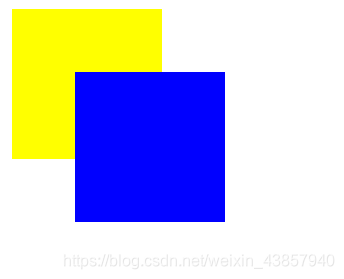1、CSS定位
position; CSS定位主要有4种:静态定位、相对定位、绝对定位、固定定位;静态定位是元素的默认定位方式,不能使用top,bottom,left,right和z-index属性,其它三种定位可以使用。(1)静态定位:static
<!DOCTYPE html>
<html>
<head>
<meta charset = "UTF-8">
<style>
div.static{
position : static ;
border : 2px dashed #73AD21 ;
}
</style>
<title>double1</title>
</head>
<body>
<div class = "static">
这个元素使用了position:static;
</div>
</body>
</html>
(2)相对定位:relative
<!DOCTYPE html>
<html>
<meta charset = "utf-8">
<head>
<title>double2</title>
<style type = "text/css">
h2.pos_left{
position : relative ;
left : -20px;
}
h2.pos_right{
position : rerlative ;
right : 20px ;
}
</style>
</head>
<body>
<h2>正常标题</h2>
<h2 class = "pos_left">相对于正常标题向左偏移</h2>
<h2 clsaa = "pos_right">相对于正常标题向右偏移</h2>
</body>
</html>

(3)绝对定位:absolute
<!DOCTYPE html>
<html>
<head>
<meta charset = "utf-8">
<title>double3</title>
<style>
#div1{
width : 100px ;
height : 100px ;
background : yellow ;
}
#div2{
width : 100px ;
height : 100px ;
background : blue ;
top : 50px ;
left : 50px ;
position : absolute;
}
</style>
</head>
<body>
<div id = "div1">
<div id = "div2"></div>
</div>
</body>
</html>

(4)固定定位:fixed;
元素的位置相对于浏览器窗口是固定位置,即使窗口是滚动的它也不会移动。
<!DOCTYPE html>
<html>
<head>
<meta charset = "utf-8">
<title>double3</title>
<style>
p.pos_fixed{
position : fixed ;
top : 5px ;
right : 5px ;
}
</style>
</head>
<body>
<p class = "pos_fixed">一个元素</p>
<p>一个元素</p>
<p>一个元素</p>
<p>一个元素</p>
<p>一个元素</p>
<p>一个元素</p>
<p>一个元素</p>
</body>
</html>
(5)粘性定位:sticky
粘性定位的元素是依赖于用户的滚动,在 position:relative 与 position:fixed 定位之间切换。它的行为就像 position:relative; 而当页面滚动超出目标区域时,它的表现就像 position:fixed;,它会固定在目标位置。
<!DOCTYPE html>
<html>
<head>
<meta charset = "utf-8">
<title>double4</title>
<style>
div.sticky{
position : -webkit-sticky ;
position : sticky ;
top : 0 ;
padding : 2px ;
bacaground-color : #cae8ca ;
border : 2px dashed #4CAF50 ;
}
</style>
</head>
<body>
<div class = "sticky">粘性定位</div>
<p>滚动我</p><p>滚动我</p><p>滚动我</p>
<p>滚动我</p><p>滚动我</p><p>滚动我</p>
<p>滚动我</p><p>滚动我</p><p>滚动我</p>
<p>滚动我</p><p>滚动我</p><p>滚动我</p>
<p>滚动我</p><p>滚动我</p><p>滚动我</p>
<p>滚动我</p><p>滚动我</p><p>滚动我</p>
</body>
</html>
注 :IE/Edge 15 及更早 IE 版本不支持 sticky 属性。
2、选择器
在 CSS 中,选择器是一种模式,用于选择需要添加样式的元素。| 选择器 | 例子 | 描述 | css版本 |
| .class | .class1 | 选择class=“class1”的所有元素 | 1 |
|---|---|---|---|
| #id | #id1 | 选择id=“id1”的所有元素 | 1 |
| * | * | 选择所有元素 | 2 |
| element | p | 选择所有<p>元素 | 1 |
| element,element | div,p | 选择所有<div>和所有<p>元素 | 1 |
| element element | div p | 选择<div>元素内部的所有<p>元素 | 1 |
| element>element | div>p | 选择父元素为 <div> 元素的所有 <p> 元素 | 2 |
| element+element | div+p | 选择紧接在 <div> 元素之后的所有 <p> 元素 | 2 |
| [attribute] | [target] | 选择带有 target 属性所有元素 | 2 |
| [attribute=value] | [target=_blank] | 选择 target="_blank" 的所有元素 | 2 |
| [attribute~=value] | [title~=flower] | 选择 title 属性包含单词 "flower" 的所有元素 | 2 |
| [attribute|=value] | [lang|=en] | 选择 lang 属性值以 "en" 开头的所有元素 | 2 |
| :focus | input:focus | 选择获得焦点的 input 元素 | 2 |
| :first-letter | p:first-letter | 选择每个 <p> 元素的首字母 | 1 |
| :first-line | p:first-line | 选择每个 <p> 元素的首行 | 1 |
| :first-child | p:first-child | 选择属于父元素的第一个子元素的每个 <p> 元素 | 2 |
| :before | p:before | 在每个 <p> 元素的内容之前插入内容 | 2 |
| :after | p:after | 在每个 <p> 元素的内容之后插入内容 | 2 |
| :lang(language) | p:lang(it) | 选择带有以 "it" 开头的 lang 属性值的每个 <p> 元素 | 2 |
| element1~element2 | p~ul | 选择前面有 <p> 元素的每个 <ul> 元素 | 3 |
| [attribute^=value] | a[src^="https"] | 选择其 src 属性值以 "https" 开头的每个 <a> 元素 | 3 |
| [attribute$=value] | a[src$=".pdf"] | 选择其 src 属性以 ".pdf" 结尾的所有 <a> 元素 | 3 |
| [attribute*=value] | a[src*="abc"] | 选择其 src 属性中包含 "abc" 子串的每个 <a> 元素 | 3 |
| :first-of-type | p:first-of-type | 选择属于其父元素的首个 <p> 元素的每个 <p> 元素 | 3 |
| :last-of-type | p:last-of-type | 选择属于其父元素的最后 <p> 元素的每个 <p> 元素 | 3 |
| :only-of-type | p:only-of-type | 选择属于其父元素唯一的 <p> 元素的每个 <p> 元素 | 3 |
| :only-child | p:only-child | 选择属于其父元素的唯一子元素的每个 <p> 元素 | 3 |
| :nth-child(n) | p:nth-child(2) | 选择属于其父元素的第二个子元素的每个 <p> 元素 | 3 |
| :nth-last-child(n) | p:nth-last-child(2) | 选择属于其父元素的第二个子元素的每个 <p> 元素,从最后一个子元素尅开始计数 | 3 |
| :nth-of-type(n) | p:nth-of-type(2) | 选择属于其父元素第二个 <p> 元素的每个 <p> 元素 | 3 |
| :nth-last-of-type(n) | p:nth-last-of-type(2) | 选择属于其父元素第二个 <p> 元素的每个 <p> 元素,从最后一个子元素开始计数 | 3 |
| :last-child | p:last-child | 选择属于其父元素最后一个子元素每个 <p> 元素 | 3 |
| :root | :root | 选择文档的根元素 | 3 |
| :empty | p:empty | 选择没有子元素的每个 <p> 元素(包括文本节点) | 3 |
| :target | #news:target | 选择当前活动的 #news 元素 | 3 |
| :enabled | input:enabled | 选择每个启用的 <input> 元素 | 3 |
| :disabled | input:disabled | 选择每个禁用的 <input> 元素 | 3 |
| :checked | input:checked | 选择每个被选中的 <input> 元素 | 3 |
| :not(selector) | :not(p) | 选择非 <p> 元素的每个元素 | 3 |
| ::selection | ::selection | 选择被用户选取的元素部分 | 3 |







 本文深入解析CSS的四种定位方式:静态、相对、绝对、固定定位,以及粘性定位的特性与应用。同时,全面介绍了CSS选择器的种类与使用场景,包括类选择器、ID选择器、通用选择器等。
本文深入解析CSS的四种定位方式:静态、相对、绝对、固定定位,以及粘性定位的特性与应用。同时,全面介绍了CSS选择器的种类与使用场景,包括类选择器、ID选择器、通用选择器等。
















 6025
6025

 被折叠的 条评论
为什么被折叠?
被折叠的 条评论
为什么被折叠?








